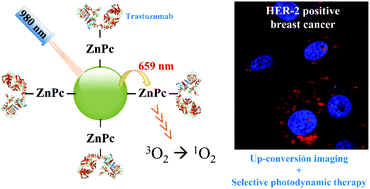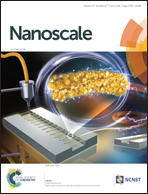An immunoconjugated up-conversion nanocomplex for selective imaging and photodynamic therapy against HER2-positive breast cancer
Abstract
Photodynamic therapy represents a very attractive therapeutic tool considered to be effective, minimally invasive and minimally toxic. However, conventional photodynamic therapy actually has two main constraints: the limited penetration depth of visible light needed for its activation, and the lack of selectivity. Considering this, this work reports the synthesis and evaluation of a novel nanoconjugate for imaging and selective photodynamic therapy against HER2-positive breast cancer, a particularly aggressive form of the disease. It was demonstrated that upon 975 nm near infrared light exposure, the red emission of the NaYF4:Yb,Er up-conversion nanoparticles (UCNPs) can be used for optical imaging and simultaneously represent the source for the excitation of a covalently bound zinc tetracarboxyphenoxy phthalocyanine (ZnPc), a photosensitizer that in turn transfers energy to ground state molecular oxygen to produce cytotoxic singlet oxygen. The specificity of our nanoconjugates was achieved by immunoconjugation with Trastuzumab (Tras), a specific monoclonal antibody for selective detection and treatment of HER2-overexpressing malignant breast cancer cells. Selective tracking of SKBR-3 HER2-positive cells was verified by confocal microscopy analysis, and the photodynamic therapy effect was considerably improved when Trastuzumab was incorporated into the nanoconjugate, the UCNPs-ZnPc-Tras being practically inert in the absence of infrared light exposure but reducing the HER2-positive cell viability up to 21% upon 5 min of the irradiation. This theranostic nanoconjugate represents a valuable alternative for HER2-positive breast cancer imaging and selective photodynamic therapy.



 Please wait while we load your content...
Please wait while we load your content...